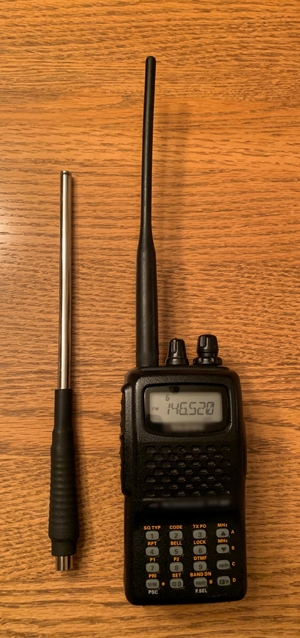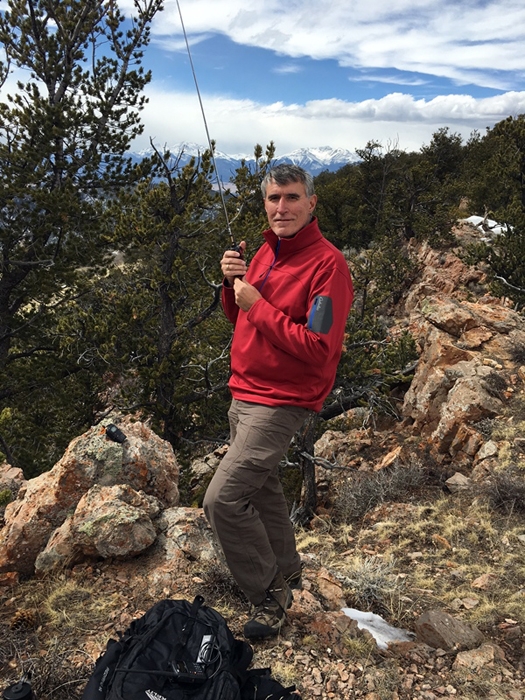On the Air Blog | Magazine | Podcast | Facebook | Join/Renew
"Summits on the Air is a great way to take ham radio outdoors. And you can do this with just a Technician license and a handheld transceiver. So get off the couch, find a summit and make some VHF radio contacts."
Radio Operating from Summits
21 April 2020
by Bob Witte, KØNR
[email protected]
In a previous blog post, I wrote about the fun of making VHF radio contacts from high places. The Summits On The Air (SOTA) program is one popular way to focus and reward this kind of activity. The basic idea of SOTA is to operate from a designated list of summits or to work other radio operators when they activate summits. The summits are assigned points based on elevation and there are scoring systems for both activators (radio operators on a summit) and chasers (radio operators working someone on a summit).
Most SOTA activity is on the HF (shortwave) bands but there are also many contacts made with VHF, mostly 2-meters FM. Obviously, HF has the advantage of being able to work longer distances without too much difficulty. Typically, the HF station is your classic portable QRP rig (a low power radio, 5 watts or less), portable antenna and battery power (a portable power source is required, and the use of fossil fuels is prohibited). Being a VHF enthusiast, I like the challenge of making contacts above 50 MHz, so my SOTA contacts are usually on 2 meters or 70 cm.
Basic VHF Gear
My most basic VHF SOTA station is a handheld FM transceiver with a ½-wave telescoping antenna (Photo 1). The standard rubber duck antenna on a handheld transceiver is generally a poor radiator so using a half-wave antenna is a huge improvement. This simple station is an easy addition to my normal hiking routine…just stuff the radio and antenna in my backpack along with the usual hiking essentials and head for the summit.

Photo 1: This basic VHF SOTA station consists of a 144/430 MHz 5-watt FM handheld transceiver and a half-wave telescopic antenna (shown collapsed).
Choose a Summit
Before you head out for a SOTA activation, it is best to spend some time on the SOTA website (www.sota.org.uk) to get a basic understanding of the program. At some point, you’ll need to choose a summit that you want to activate. A useful tool for that is the SOTA Atlas (SOTLAS, sotl.as), which shows all SOTA summits on an easy to navigate map.
Also, take a look at the SOTAwatch website (sotawatch.sota.org.uk) where an activator can post an advance notice, called an Alert, of their planned activation. Later, they can post a Spot which indicates they are actually on the air from the summit. This helps the chasers to become aware of your activation and to be looking for you on the right frequency.
Photo 2: Caption: Bob K0NR operating 2m FM from North Kaufman Ridge (W0C/SP-085)
Make Contacts
To receive activation points for SOTA, you need to make a minimum of 4 contacts from the summit. When activating within range of a populated area, you can usually just be successful calling CQ on the 2 Meter FM National Simplex Calling Frequency, 146.52 MHz. (Tip: for your first VHF SOTA activations, you should probably activate a summit that is within 30 or 40 miles of a city.) If the calling frequency gets busy, it is a good idea to move off to another simplex frequency. If you can’t raise anyone on simplex, you can ask for help on a local 2M repeater -- to see if someone will come over to simplex to make a contact. SOTA does not recognize repeater contacts but it is OK to solicit simplex contacts using a repeater. Hopefully, you won’t need to do that.
According to the SOTA rules, a valid contact requires the exchange of callsigns and signal reports. Each SOTA summit has a specific reference number that identifies it, as listed on the SOTA website. This limits confusion due to multiple summits with the same name. Otherwise, we would constantly have to explain “which Black Mountain are you on?” You should know the SOTA reference for your summit and give it out during your radio contacts. For example, the SOTA reference for North Kaufman Ridge, a popular SOTA summit in Colorado, is W0C/SP-085. “W0C” is the indicator for the Colorado association, “SP” means the “South Park” region and “085” is an assigned number.
Log the Information
Make sure you log the radio contacts that you complete. Specifically, this means writing down the call sign of the other station, frequency and time of the contact. (ARRL tip: order a "logbook" or "minilog" from the ARRL store, www.arrl.org/shop to include in your backpack.) When you get back home, you’ll need to enter the log information into the SOTA database to get credit for the activation. QSL cards or any other confirmation are not required -- SOTA operates on the honor system.
Summits on the Air is a great way to take ham radio outdoors. And you can do this with a Technician license and a handheld transceiver. So get off the couch, find a summit and make some VHF radio contacts.
Safety note: This post focused on the radio aspect of a SOTA activation. Some SOTA summits are challenging climbs, so make sure you have the proper equipment and training before attempting a summit.
More VHF operating ideas and tips can be found in my book: VHF, Summits and More: Having Fun With Ham Radio, available from the ARRL store at www.arrl.org/shop/VHF-Summits-and-More.
ARRL Resources for Learning More
“Repeaters — Your Friends in High Places” On the Air magazine Jan/Feb 2020, www.arrl.org/ota
The ARRL Repeater Directory® (produced annually) http://www.arrl.org/shop/The-ARRL-Repeater-Directory
Share Your Stories
Whether you are new, an expert or somewhere in between we invite you to take part in the conversation. Share your stories and experiences by emailing [email protected].
Click here to return to the On the Air Blog main page.
News & Features >> On the Air Magazine >> On the Air Blog >> Radio Operating from Summits














